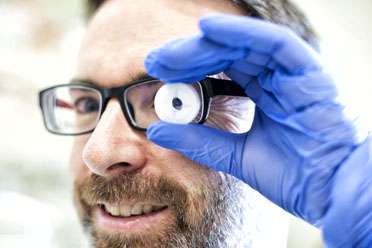New hope for patients with macular degeneration

Macular degeneration is a leading cause of blindness in Australia, affecting one in seven people over the age of 50.
The impact of this disease that impairs the central field of vision is profound but thanks to research being conducted by QUT scientists and students a new treatment for macular degeneration is under development.
Associate Professor Damien Harkin of the School of Biomedical Sciences at QUT has spent the last seven years developing innovative ways to repair the eye in collaboration with scientists and clinicians at the Queensland Eye Institute (QEI).
A novel aspect of this work has been to explore the use of proteins found in silk as materials on which to grow and transplant new eye tissue.
Having successfully applied this concept to corneal stem cells, Professor Harkin and his QEI-based team have now turned their attention to the challenge of treating diseases of the retina and in particular macular degeneration.
"The ultimate goal of our research is to develop an effective, affordable and accessible treatment for patients afflicted with age-related macular degeneration," Professor Harkin said.
"The use of stem cells in conjunction with silk proteins is just one of many good ideas worth investigating."
Supported by The Macular Diseases Foundation of Australia (MDFA), Professor Harkin and his team were recently awarded a prestigious grant to explore the potential of silk proteins as materials for repairing the retina.
QUT students past and present have played a vital role in Professor Harkin's important research including Dr Laura Bray who was awarded the inaugural Prime Minister's Queen Elizabeth II Diamond Jubilee Award in 2012 to continue her studies of corneal tissue engineering using silk proteins in Dresden, Germany.
More recently, the group's studies of the retina have been driven by the efforts of Ms Audra Shadforth, who is exploring the use of silk proteins as a scaffold for retinal pigment epithelial (RPE) cells.
"RPE cells are responsible for maintaining the survival and function of the retinal cells that are required to sense light (rods and cones)," Ms Shadforth said.
"As the retina ages, the RPE cells in some people appear to become 'tired' and can eventually die, leading to vision loss.
"Damage can also occur within the surrounding tissue, resulting in bleeding into the back of the eye. Our goal is to produce a patch of healthy retinal tissue that repairs the damage while also supplying new healthy RPE cells."
Professor Harkin's team will move in early 2014 to a purpose built eye research facility within the new Queensland Eye Institute and South Bank Day Hospital at 140 Melbourne Street, South Brisbane.


















